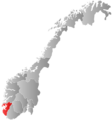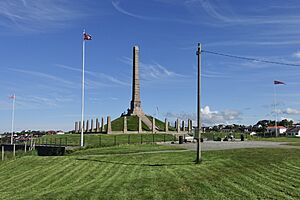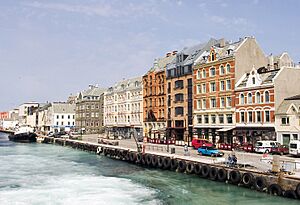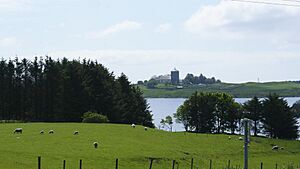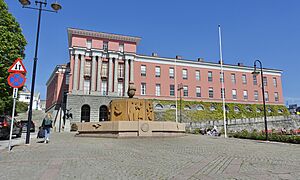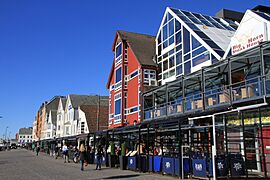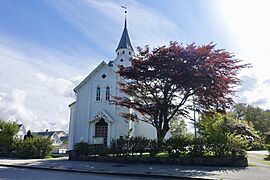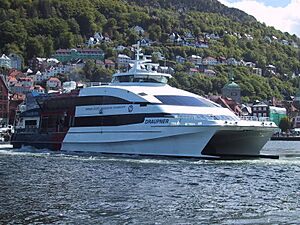Haugesund facts for kids
Quick facts for kids
Haugesund kommune
|
|||||
|---|---|---|---|---|---|
|
Municipality
|
|||||

Smedasundet in Haugesund
|
|||||
|
|||||
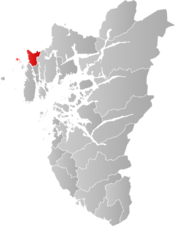
Haugesund within Rogaland
|
|||||
| Country | Norway | ||||
| County | Rogaland | ||||
| District | Haugaland | ||||
| Established | 1 Feb 1855 | ||||
| Administrative centre | Haugesund | ||||
| Area | |||||
| • Total | 72.69 km2 (28.07 sq mi) | ||||
| • Land | 68.38 km2 (26.40 sq mi) | ||||
| • Water | 4.31 km2 (1.66 sq mi) 5.9% | ||||
| Area rank | #338 in Norway | ||||
| Population
(2023)
|
|||||
| • Total | 37,855 | ||||
| • Rank | #28 in Norway | ||||
| • Density | 553.5/km2 (1,434/sq mi) | ||||
| • Change (10 years) | 5.9% | ||||
| Demonyms | Haugesundar Haugesunder |
||||
| Time zone | UTC+01:00 (CET) | ||||
| • Summer (DST) | UTC+02:00 (CEST) | ||||
| ISO 3166 code | NO-1106 | ||||
| Official language form | Bokmål | ||||
| Preceded by | Torvastad Municipality | ||||
|
|
|||||
Haugesund is a municipality and town located on the North Sea in Rogaland county, Norway. As of December 2023, about 37,855 people live here. Most of them (37,008) live in the main urban area of Haugesund. This urban area also stretches into the nearby Karmøy municipality, making its total population around 46,359.
Haugesund is the main business and economic hub for the Haugaland region in northern Rogaland and southern Vestland. Outside the main town, most of the municipality is rural or undeveloped. Haugesund covers about 72.68 square kilometers. It is the 28th most populated municipality in Norway. The number of people living here has grown by 5.9% over the last 10 years.
The urban area of Haugesund, which includes parts of Karmøy, covers about 15.5 square kilometers. About 8,884 people from this urban area live in Karmøy. Only about 1,000 residents of Haugesund municipality live in the rural parts, which cover about 57 square kilometers.
Contents
- Discovering Haugesund's Location
- Haugesund's Rich History
- Geography and Climate in Haugesund
- Exploring Haugesund's Cityscape
- Getting Around Haugesund: Transport
- Healthcare in Haugesund
- Haugesund's Vibrant Culture
- Learning in Haugesund: Education
- Sports in Haugesund
- Haugesund's International Connections
- Notable People from Haugesund
- See also
Discovering Haugesund's Location
The town of Haugesund is built on a very important sound called Karmsundet. This waterway allowed ships to pass without having to go into the rough open sea. In the past, the waters near Haugesund were full of herring fish, which helped the town grow a lot. Even though it was just a small village back then, King Harald Fairhair lived very close by, in Avaldsnes.
Today, the town has shifted its focus to the petroleum industry, as the herring fishing is not as big as it used to be. Over the last 20 years, Haugesund has become the main shopping and trading center for the Haugaland region and southern parts of Vestland county. It has several large shopping centers, though this has made the town center a bit quieter for shopping.
The wider Haugesund Region is a statistical area that includes Haugesund and the municipalities of Karmøy, Tysvær, Sveio, and Bokn. In 2009, this region had about 100,000 people.
Haugesund's Rich History
Even though Haugesund is a fairly new town, the areas around it were very important during the Viking Age. Harald Fairhair was the first king of Norway. He lived in Avaldsnes, also known as the "Homeland of the Viking Kings," which is only about 8 kilometers from modern Haugesund.
After his death around 940 AD, many believe King Harald Fairhair was buried at Haraldshaugen. This is a burial mound next to the Karmsundet strait. The town and municipality of Haugesund are named after this site. The national monument at Haraldshaugen was built in 1872. It celebrates the 1000th anniversary of the Battle of Hafrsfjord in 872. This battle is traditionally seen as the moment when western Norway was first united under one king.
Haugesund has always had a strong connection to the sea, especially to herring fishing. In earlier times, the coastal waters of Haugesund were a huge source of herring. This helped the town grow a lot. The protected straits of Smedasund and Karmsund were perfect for fishing and shipping. Even today, Karmsund is one of Norway's busiest waterways. The town continues to grow geographically, even if its population has only increased a little in the last decade. Now that herring are not as plentiful, the town is focusing more on the petroleum industry, similar to its neighbor to the south, Stavanger.
How Haugesund Became a Municipality
The urban village area of Haugesund, with 1,066 people, was officially declared a "town" on February 1, 1855. It then became its own separate municipality, splitting from the larger Torvastad Municipality.
Later, on January 1, 1911, a small urban area of Skåre (with 3,847 people) that was right next to Haugesund was added to the town. On January 1, 1958, the rest of Skåre municipality merged with Haugesund, making it much larger. Finally, on January 1, 1965, the island of Vibrandsøy (with 70 people) was transferred from Torvastad municipality to Haugesund.
The Meaning Behind the Name Haugesund
The name of the municipality and town comes from the Haugesundet strait. This strait is named after an old farm called Hauge. The first part of the name, Hauge, comes from an old Norwegian word meaning "hill" or "mound." The second part, sund, means "strait" or "sound."
Haugesund's Coat of Arms
Haugesund's first coat of arms was approved on December 29, 1862. It was used until March 5, 1930. This old design showed a harbor scene. It featured three full herring barrels on land with an anchor leaning against them. In the background, you could see the ocean harbor and three seagulls flying. This design showed how important herring fishing and processing were to the town. The three barrels also represented the three parts of the municipality: the mainland and the islands of Hasseløy and Risøy.
A new coat of arms was approved on March 5, 1930, to replace the old one and make it simpler for the town's 75th anniversary. The new design has a blue background with three white seagulls flying. It also includes a gold mural crown above the shield. The seagulls and the blue color were chosen to show the importance of the sea. The new arms removed the herring barrels because the fishing industry was not as central anymore. The municipal flag has the same design as this coat of arms.
Geography and Climate in Haugesund
Haugesund municipality is located on the North Sea coast. However, the island of Karmøy and the archipelago of Røvær protect it from the ocean's rough waves. The Karmsundet strait, between Karmøy and Haugesund, was once very important. It allowed ships to pass without sailing through heavy seas. Haugesund's city center has a unique street layout, similar to cities like Kristiansand and Oslo.
The municipality includes several islands. Risøy and Hasseløy are densely populated and connected to the mainland by bridges. Røvær, which is further out and made up of many islands, is also populated and connected by ferry. Vibrandsøy and its nearby islands are now mostly used for recreation. The Røværsholmen Lighthouse is just off the coast of the main Røvær island. The lakes Vigdarvatnet and Stakkastadvatnet are also found in the municipality.
Haugesund has an oceanic climate, meaning it has rainy winters and mild, pleasant summers. The highest temperature ever recorded was 31.2°C in July 2019. The lowest was -16.6°C in January 2010. The wettest time of year is autumn and winter, while April to July is the driest season. Haugesund Airport, located in Karmøy municipality about 8 kilometers from Haugesund, has been collecting weather data since 1975.
Exploring Haugesund's Cityscape
Haugesund City Hall was built in 1931. It celebrated its 75th anniversary in 2006. This pink city hall, designed by Gudolf Blakstad and Herman Munthe-Kaas, is one of the most beautiful neo-classical buildings in Norway. It has even been chosen as the most beautiful building in Haugesund. The building is also featured in the Norwegian edition of the game Monopoly. It cannot be changed without permission from the national preservation agency. The city hall overlooks the town square and a park, which opened on August 28, 1949.
As mentioned, Haugesund has become the main trading center for its region. It has several large shopping centers. However, this has led to less shopping activity in the town center itself.
There are several churches in Haugesund. These include Vår Frelsers Church, Udland Church, Rossabø Church, and Skåre Church.
Getting Around Haugesund: Transport
Haugesund Airport is located on the island of Karmøy, southwest of Haugesund. It has flights all year round to Oslo and Gdańsk in Poland. There are also some seasonal and charter flights. The Norwegian airline Coast Air used to be based at Haugesund airport, but it went out of business in 2008.
The European Route E39 goes around Haugesund to the east, passing through Aksdal. The European Route E134 goes east towards Drammen, near Oslo.
The bus station in Haugesund is at Flotmyr, on the east side of downtown. You can take long-distance buses to Stavanger, Bergen, and Oslo. Local bus services are run by Vy Buss.
The town is connected to the island of Utsira by a car ferry. Passenger ferries connect it to the islands of Røvær and Feøy. Until 2008, a ferry route from Newcastle to Bergen and Stavanger also stopped here.
Healthcare in Haugesund
Haugesund Hospital provides special health services to about 180,000 people. These people live in North Rogaland, Sunnhordland, Hardanger, and Ryfylke.
The hospital offers many services. These include medicine, surgery, X-rays, childbirth, maternity care, gynecology, and fertility treatments. It also provides help for mental health. In addition, there are more than 10 public and private health centers in the municipality. These centers offer general or specialized care, including the Privatsykehuset Haugesund.
Haugesund's Vibrant Culture
Haugesund is the main cultural center for its region. It hosts several festivals. The biggest ones are the Norwegian International Film Festival and Sildajazz. Sildajazz is an international jazz festival with about 70 bands and nearly 200 concerts. This festival takes place every August. It features both local and international musicians.
From 2004 to 2009, the annual rock festival "RockFest" was held here. It brought in local, national, and international pop and rock bands. Famous artists like Elton John, Madcon, DumDum Boys, and Kaizers Orchestra performed. The festival started as part of Haugesund's 150-year anniversary celebration. In 2010, "RockFest" was replaced by a new idea called "Haugesund Live." This is a series of individual concerts. It has featured bands like the Baseballs, Kim Larsen, and Mötley Crüe.
The Norwegian International Film Festival has been held in Haugesund since 1973. It shows new international and Norwegian films. The Amanda Award, which is like Norway's version of the Oscars, has been given out in Haugesund since 1985, at the same time as the film festival.
Haugesunds Avis is a daily newspaper published in Haugesund. It also has offices in Bømlo, Kopervik, Odda, Sauda, and Stord. The newspaper was started in 1895. Today, it is owned by the Mecom Group and is part of the media group Edda Media. In 2006, Haugesunds Avis printed 33,448 copies. The newspaper also owns the local radio channel Radio 102.
The Church of Norway has three parishes (local church areas) in Haugesund municipality.
Learning in Haugesund: Education
The main campus of Stord/Haugesund University College is in Haugesund. It was created in 1994 by combining three colleges: Haugesund Nursing College, Stord Teachers College, and Stord Nursing College. This university college has about 2,700 students and 260 staff members. It is one of the smaller university colleges in Norway.
The Rogaland county runs four high schools in Haugesund. The schools Skeisvang and Vardafjell prepare students for college or university studies. The schools Haugaland and Karmsund are vocational high schools, which teach skills for specific jobs. There is also a private high school, Haugesund Toppidrettsgymnas, which focuses on sports.
The municipality has seven elementary schools for grades 1 to 7. These are Saltveit, Gard, Austrheim, Solvang, Lillesund, Rossabø, and Brakahaug. There are two middle schools for grades 8 to 10: Haraldsvang and Håvåsen. Three schools combine grades 1 to 10: Hauge, Røvær, and Skåredalen. The Breidablik school offers elementary and middle school classes for new foreigners and refugees. There are also two private schools: Steinerskolen, which offers a Waldorf education program, and Danielsen, a Christian school for grades 8 and 9.
Sports in Haugesund
Football (Soccer)
The strongest local football team is FK Haugesund. They have been in the Norwegian Premier League since 2010. The team plays its home matches at Haugesund Stadion.
Other local football teams include Vard Haugesund, Djerv 1919, and SK Haugar.
Other Sports
- Haugesund IL: For athletics.
- Haugesund Seagulls: For ice hockey.
- Haugesund Turnforening: For gymnastics.
Haugesund's International Connections
Twin Towns – Sister Cities
Haugesund has sister city agreements with the following places:
 Ekenäs, Uusimaa, Finland
Ekenäs, Uusimaa, Finland Emden, Lower Saxony, Germany
Emden, Lower Saxony, Germany Søllerød, Hovedstaden, Denmark
Søllerød, Hovedstaden, Denmark Ystad, Skåne, Sweden
Ystad, Skåne, Sweden
Each of these sister cities (except Emden) has a street named after it in Haugesund. These streets are all in the same area, near the border of the neighboring municipality.
Notable People from Haugesund
- Hanna Brummenæs (1860-1942), a woman who owned a shipping company and was a City Councillor.
- Eivind Nielsen (1864–1939), a painter and illustrator of children's books.
- Egil Eide (1868–1946), a silent film actor and director.
- Hanne Krogh (born 1956), a singer and actress who won the Eurovision Song Contest 1985.
- Jon Fosse (born 1959), a famous author and playwright.
- Turid Birkeland (1962–2015), a cultural leader and former politician.
- Steffen Kverneland (born 1963), an illustrator and comics writer.
- Captain Frodo (born 1976), a contortionist who holds a Guinness World Record.
- Gunhild Stordalen (born 1979), a doctor and environmental activist.
- Susanne Sundfør (born 1986), a singer-songwriter and record producer.
Notable Sportspeople
- Stig Traavik (born 1967), a former judo athlete who competed in the 1992 Summer Olympics.
- Egil Østenstad (born 1972), a former football player for clubs and the Norwegian national team.
- Christian Grindheim (born 1983), a retired football player with many club and national team appearances.
- Alexander Søderlund (born 1987), a football player with over 300 club games and 32 for the Norwegian national team.
- Sven Erik Bystrøm (born 1992), a Norwegian road bicycle racer.
- Tommy Langaker (born 1994), a Brazilian Jiu Jitsu athlete and the first Norwegian Black Belt World Champion in his sport.
See also
 In Spanish: Haugesund para niños
In Spanish: Haugesund para niños




